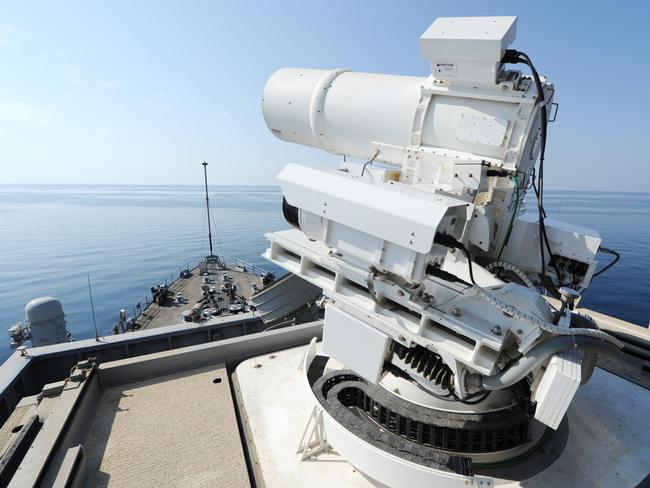US navy’s new $192m laser cannons can fry boats, drones and incoming missiles
THE US navy’s terrifying new weapon cost it hundreds of millions, but it will be unlike anything the world has ever seen.
THE US navy has bought two incredible laser cannons that are capable of blasting drones out of the sky.
These so-called “high-energy lasers” use huge amounts of power to destroy their targets, and will soon be loaded on to operational warships, reports The Sun.
The lasers were built by Lockheed Martin and can be used to strike boats and small drones.
But by boosting the power from 150kW per shot to 300kW, it’s possible to destroy incoming missiles — before they hit their targets.
The pair of cannons cost the US navy $192 million, but that’s a small fee for the added security the mega-lasers will bring.
One laser will remain on land, and will be used for military testing purposes.
The second laser cannon, however, will be loaded onto an Arleigh Burke-class destroyer ship as soon as 2020, according to Motherboard.

Unfortunately, the cost of the US navy contract with Lockheed Martin could spiral to nearly a billion dollars.
A statement from the US Department of Defence reads: “Lockheed Martin Aculight Corp will develop, manufacture and deliver two test units in fiscal 2020.
“This contract includes options which, if exercised, would bring the cumulative value of this contract to $US942,818,114.”
It’s the USA’s latest bid to modernise its military defences to keep pace with China.
Speaking in 2016, then vice chief of naval operations Admiral William Moran said: “Low-cost directed energy weapons have to be part of our future.
“If we have to continue to rely on projectiles, we will run out of the ability to defend ourselves.”
The news comes as news China could be developing a terrifying ship-mounted rail gun that could significantly upgrade the country’s naval warfare capabilities.
Experts say that images being shared on social media show the warship Haiyang Shan being loaded with the space-age weapon.
A rail gun is a type of weapon that uses powerful electromagnets to accelerate projectiles to very high speeds.
Conventional weapons typically use explosives or propellant to launch ammunition, but electromagnetic forces make it possible for a rail gun to achieve a much higher “muzzle velocity”.
This means that while a normal gun might manage a projectile speed of around 2km/s, a rail gun could blast out projectiles faster than 3km/s.
It also means that you don’t need to transport explosive propellants or warheads, which could make a rail gun-toting warship much safer than traditional vessels.
The railgun's 3D model made by 模人一架. pic.twitter.com/pNVG2PPwBr
— dafeng cao (@xinfengcao) February 3, 2018
Details of China’s rail gun have been leaked online by an analyst called Dafeng Cao, who observes China’s People’s Liberation Army Navy (PLAN).
Cao sourced a number of images of a PLAN Type 072III-class warship from China’s social media site Weibo, apparently showing a rail gun on board.
The analyst says there are several key clues, including the short, thick barrel, which would be unsuitable for long-range explosive weapons.
He also cites a verified Weibo account that reportedly belongs to a retired China naval officer, who said that a ship-mounted rail gun had been approved years ago.
According to the officer, the Haiyang Shan warship was a great platform to test the weapon thanks to its large deck area.
If China is successful, it would be the world’s first ship-mounted rail gun — a feat not even achieved by the US.
This story first appeared on The Sun and is reproduced here with permission.



